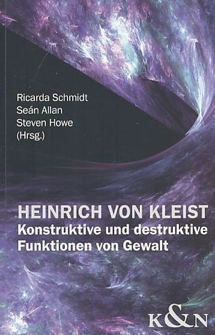Constructive and Destructive Functions of Violence in the Work of Heinrich von Kleist
2011 marked the bicentenary of the death of Heinrich von Kleist. Kleist's work has provoked a huge range of often diametrically opposed interpretations, and throughout history Kleist scholars have tried to appropriate the writer for the most diverse of causes: nationalist – even national-socialist – critics staked a claim to his work, as did critics working in existentialist, Marxist, psychoanalytic, feminist, and deconstructionist schools of criticism. In an article written for the Königsberger Hartungsche Zeitung to mark the first centenary of Kleist's death, the critic Jakob Minor wrote that, despite everything that had been written about Kleist's work, it remained an unsolved problem – possibly the greatest problem in literary history.
Now, just over a century later, it seems appropriate to ask what literary criticism has added to our understanding of this writer over the last century, and how his oeuvre is viewed today. Our collective experience over the past hundred years – an experience that includes two world wars, terrorist attacks on a worldwide scale, the relentless struggle for dominance in the sphere of political ideology, and the dramatic rise of domestic violence – has made us especially attuned to one particular aspect of Kleist's work: the presentation of violence. Forms of violence in Kleist's work range from rape, infanticide, murder, suicide, lynching at one end of the spectrum, to terrorism, rebellion, guerrilla warfare, military conflict and to state executions at the other.
The Exeter conference exploited the bicentenary of Kleist's death to launch an investigation into both the destructive and constructive aspects of violence in Kleist's oeuvre. Some of Kleist's works seem to offer a justification of violence as a means to a higher end, although today these ends often appear increasingly questionable. In other texts the representation of violence has been read as a critique of draconian social structures, oppressive ideological beliefs, ill-conceived anthropological assumptions, and patriarchal concepts of gender - that is to say as a form of constructive criticism designed to promote social structures of a more liberal kind. How are such mutually antagonistic points of view embedded in Kleist's individual works and in his oeuvre as a whole? Does the representation of violence in his work point to a position of nihilism or humanism, to a pessimistic view of history or to an idealistic attempt to influence the course of history for the better? How are we to evaluate Kleist's representation of violence in its historical and literary context – and from a distance of 200 years? What roles do language and narrative structure play in the representation of violence in his texts? What does the presentation of violence in his work tell us about Kleist's relationship to the philosophy of the Enlightenment? What insights can we draw from Kleist's texts about forms of violence - both individual and collective - and about the inter-relationship between love, power and violence today?
- View the conference programme
- View the list of abstracts
- View the list of participants

Heinrich von Kleist. Konstruktive und destruktive Funktionen von Gewalt. Hrsg. von Ricarda Schmidt, Seán Allan und Steven Howe (Würzburg: Königshausen und Neumann, 2012).